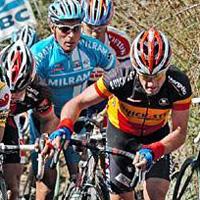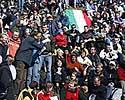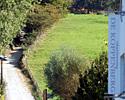
Recently on Cyclingnews.com |
Tales from the peloton, February 29, 2008
Spring fever
Nobody can imagine a spring without the Belgian classics on their horrible roads anymore. The races are very popular with the fans, who come out in the thousands. Cyclingnews' Les Woodland gives a history lesson on how the classics became what they are today.

|
There was a moment you may have missed in the Tour last summer. It had nothing to do with the riders and not much with the race. It was all about French policemen, Belgian bike fans and a nation in crisis. When the Tour goes abroad, the motorbike police goes with it. They hand in their guns, because now they are just foreigners on a working trip, and for the same reason they have no power of arrest. That takes a lot off a policeman's mind and he can relax and joke with the crowd. And it was that happy atmosphere that led two or three French gendarmes to accept the yellow flags that the fans offered them in Belgium.
French policemen speak French. Belgians, where they wave yellow flags with lions on them, speak Dutch. Few Frenchmen speak Dutch and so the policemen had no idea what the fans were saying as they stuck flags on their motorbikes. But they did understand the minority of French-speaking fans and it didn't take long to realise that they were hopping mad. Because not only is that yellow flag a symbol of pride in Flanders, but Flanders was close to splitting from the French-speaking south and bringing an end to the nation of Belgium.
Belgian history is riven by clashes between the French-like southerners and the Flemish of the north, more like the neighbouring Dutch or Germans, although not convincingly, either. If ever a bike race exemplified that clash, it's the Tour of Flanders. The Ronde restarted four months after the last shot of world war one. In world war two the show never closed. The last peacetime race was on April 2, 1939. Germany invaded on May 10 and the Tour of Flanders went on regardless. German soldiers were among the spectators. Southern Walloons perceived bad taste in running a bike race when thousands were dying in the Ardennes. Especially when they already suspected the north of being less resistant to the Germans than a good Belgian ought to be.

|
And, to be honest, so did some northern Belgians. The rival race, Het Volk, started in 1945 to cock a snook at the Tour of Flanders and its perceived collaboration. But in the end, tradition is all. The Tour of Flanders was too well established for Het Volk to supplant and its organiser, Karel van Wijnendaele, too entrenched in the hierarchy of Belgian cycling. For 20 years he picked and managed the Belgian team in the Tour de France.
Just as Het Volk wanted to rival the Tour of Flanders, so van Wijnendaele wanted to challenge Liège-Bastogne-Liège. Why? Because Liège-Bastogne-Liège is as much a celebration of southern pride as the Tour of Flanders became a badge for the north. He had no trouble picking a course. He just got out a map and pencilled in the roads. Then he wrote to towns to tell them he was coming. He didn't set out to use bad roads. Almost all roads were bad.
The appeal to the pride of the north, long oppressed by the south, made the race an instant success. Crowds turned out and at times everyone in Flanders who owned a car joined in with the bunch. The police sent out motorcyclists to fine them, but it made no difference. Long lines of cars formed behind the race and between groups. Traffic came to a halt for an hour. There were cars two and sometimes three deep on the climbs. The police were powerless and in the end only the fuel rationing of the second world war ended the problem. Defeat was swift for Belgium. Belgians went to bed as neutrals on May 9 and woke on May 10 to find Germans on the street: Germans who also turned out watch the Tour of Flanders.
Belgium survived that war as it had the one before. And it changed many things. After twice being the cockpit of global conflict, Belgium became the first European state to open its borders - even to Germans. It picked itself up from devastation. Towns began asphalting roads, ridding themselves of cobbles, taking a pride in the future rather than clinging to the past.
The Tour of Flanders still used the bad roads that remained because that way it avoided the traffic of the main highways. But then the first classic hill was surfaced. If the Tour of Flanders was one day going to bowl round on roads as smooth as a baby's bottom, it wasn't going to be the Tour of Flanders any more. Karel Van Wijnendaele could see that. Unable any more to draw a circle around Flanders and call that his course, he had to buy maps of tracks and paths. His staff went out to talk to men who knew the roads that maps didn't show. 'It was either that or risk the race ending in a mass sprint, and that's the last thing they wanted,' said the race historian Tom van Laere.

|
The more Belgium surfaced its roads, the more the Tour of Flanders had to find back roads. Bad back roads. The total length of cobbles decreased but the number of cobbled hills rose. Now they come one after the other, almost half the race ridden: Den Ast, Achterberg ('back hill'), Wolvenberg ('wolves hill'), Kluisberg ('hermitage hill'), Oude Kwaremont, Kruisberg ('cross hill'), Bossenaarberg ('woodman's hill'), Eikenberg ('oaks hill'), Molenberg ('mill hill'), Bosberg ('wood hill'), and so on. There are around 15.
The dreadful Koppenberg, so dangerous that it was banished for years, rears at 25 per cent on a tractor's width of shallow cobbles between gutters and grass banks. Thousands behind makeshift fencing watch the mayhem. Yet the hills are new. The Kluisberg was tried in 1955, abandoned until 1966 and didn't reappear until 1992. The 1,600m of narrow cobbles of the Oude Kwaremont came for the first time in 1974. Geraardsbergen, which you may know by its French name of Grammont, was fully cobbled in 1950. It survived until 1952 and came back in 1970, by which time the first 325 metres had been surfaced.
It's a tribute to what is merely a bike race that the Tour of Flanders has rock-style merchandise. What better than a Ronde wristwatch, 'a sport version provided with hour, minute and second hands, date, heavy rust-free metal body, shock-resistant mechanism and shatterproof glass, tested at 100 metres below water, equipped with massive rust-free steel strap with double slot for safety'? Or a titanium version. Both with a Velcro 'sports strap' marked 'Ronde van Vlaanderen.'
The one thing that links all Belgian classics is that nobody likes them. Of all those, the one they hate most is the Tour of Flanders. Which is just what makes it a great race, of course.
Photography
For a thumbnail gallery of these images, click here
Images by Roberto Bettini/www.bettiniphoto.net
- On the Koppenberg, even the pros have to take a hike sometimes, when the steep gradient and the cobbles, combined with the slow speed of the big bunchgrinds the peloton to a halt.
Images by Luc Claessen/www.ctm-images.com
- The spectators are out in the thousands and occupy every spot they can on the landmark climbs.
Images by Bjorn Haake/Cyclingnews.com
- The Koppenberg looks innocent enough at the bottom, but gets really steep in the middle part.
